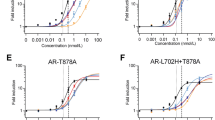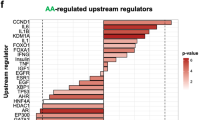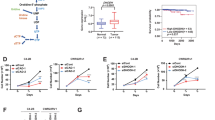Abstract
Epidemiological data on prostate cancer incidence has suggested that vitamin D deficiency may be a risk factor for prostate cancer. The antiproliferative activity of 1α, 25-dihydroxyvitamin D3 (1,25-VD) and its analogues has been demonstrated in many prostate cancer models, yet the detailed mechanisms underlying this protective effect of vitamin D remain to be determined. Here, we demonstrate that two androgen receptor (AR)-positive prostate cancer cell lines, LNCaP and CWR22R, are more sensitive to the growth inhibitory effects of 1,25-VD compared to the AR-negative prostate cancer cell lines, PC-3 and DU 145. 1,25-VD treatment inhibited cyclin-dependent kinase 2 (cdk2) activity and induced G0/G1 arrest. Interestingly, we also found that 1,25-VD treatment induced the expression of AR, and that the onset of the G0/G1 arrest in LNCaP and CWR22R cells is correlated with the onset of increasing expression of AR. This implies that the antiproliferative actions of 1,25-VD in AR-positive prostate cancer might be mediated through AR. Furthermore, a reduction in 1,25-VD-mediated growth inhibition was observed when AR signaling was blocked by antiandrogens, AR RNA interference, or targeted disruption of AR. Taken together, our data suggest that the androgen/AR signaling plays an important role in the antiproliferative effects of 1,25-VD and restoration of androgen responsiveness by 1,25-VD might be beneficial for the treatment of hormone-refractory prostate cancer patients.
This is a preview of subscription content, access via your institution
Access options
Subscribe to this journal
Receive 50 print issues and online access
$259.00 per year
only $5.18 per issue
Buy this article
- Purchase on Springer Link
- Instant access to full article PDF
Prices may be subject to local taxes which are calculated during checkout







Similar content being viewed by others
Abbreviations
- 1,25-VD:
-
1α,25-dihydroxyvitamin D3
- VDR:
-
vitamin D receptor
- AR:
-
androgen receptor
- Rb:
-
retinoblastoma
- RNAi:
-
RNA interference
References
Bikle DD . (1992). Endocr. Rev., 13, 765–784.
Blutt SE, Allegretto EA, Pike JW and Weigel NL . (1997). Endocrinology, 138, 1491–1497.
Chlenski A, Nakashiro K, Ketels KV, Korovaitseva GI and Oyasu R . (2001). Prostate, 47, 66–75.
Chu YW, Wang R, Schmid I and Sakamoto KM . (1999). Cytometry, 36, 333–339.
Darwish H and DeLuca HF . (1993). Crit. Rev. Eukaryot. Gene Expr., 3, 89–116.
Esquenet M, Swinnen JV, Heyns W and Verhoeven G . (1996). Prostate, 28, 182–194.
Hanchette CL and Schwartz GG . (1992). Cancer, 70, 2861–2869.
Haussler MR, Whitfield GK, Haussler CA, Hsieh JC, Thompson PD, Selznick SH, Dominguez CE and Jurutka PW . (1998). J. Bone Miner. Res., 13, 325–349.
Hedlund TE, Moffatt KA and Miller GJ . (1996). J. Steroid Biochem. Mol. Biol., 58, 277–288.
Henttu P, Liao SS and Vihko P . (1992). Endocrinology, 130, 766–772.
Hofman K, Swinnen JV, Verhoeven G and Heyns W . (2001). Biochem. Biophys. Res. Commun., 283, 97–101.
Inoue T, Kamiyama J and Sakai T . (1999). J. Biol. Chem., 274, 32309–32317.
Jones G, Strugnell SA and DeLuca HF . (1998). Physiol. Rev., 78, 1193–1231.
Kliewer SA, Umesono K, Noonan DJ, Heyman RA and Evans RM . (1992). Nature, 358, 771–774.
Knudsen KE, Arden KC and Cavenee WK . (1998). J. Biol. Chem., 273, 20213–20222.
Lee MS, Igawa T, Yuan TC, Zhang XQ, Lin FF and Lin MF . (2003). Oncogene, 22, 781–796.
Liao J, Ozono K, Sone T, McDonnell DP and Pike JW . (1990). Proc. Natl. Acad. Sci. USA, 87, 9751–9755.
Liu M, Lee MH, Cohen M, Bommakanti M and Freedman LP . (1996). Genes Dev., 10, 142–153.
Lu S, Jenster G and Epner DE . (2000). Mol. Endocrinol., 14, 753–760.
Lu S, Liu M, Epner DE, Tsai SY and Tsai MJ . (1999). Mol. Endocrinol., 13, 376–384.
MacDonald PN, Dowd DR and Haussler MR . (1994). Semin. Nephrol., 14, 101–118.
MacDonald PN, Dowd DR, Nakajima S, Galligan MA, Reeder MC, Haussler CA, Ozato K and Haussler MR . (1993). Mol. Cell. Biol., 13, 5907–5917.
Miller GJ, Stapleton GE, Ferrara JA, Lucia MS, Pfister S, Hedlund TE and Upadhya P . (1992). Cancer Res., 52, 515–520.
Miller GJ, Stapleton GE, Hedlund TE and Moffat KA . (1995). Clin. Cancer Res., 1, 997–1003.
Munker R, Kobayashi T, Elstner E, Norman AW, Uskokovic M, Zhang W, Andreeff M and Koeffler HP . (1996). Blood, 88, 2201–2209.
Muto A, Kizaki M, Yamato K, Kawai Y, Kamata-Matsushita M, Ueno H, Ohguchi M, Nishihara T, Koeffler HP and Ikeda Y . (1999). Blood, 93, 2225–2233.
Myers RB, Oelschlager D, Manne U, Coan PN, Weiss H and Grizzle WE . (1999). Int. J. Cancer, 82, 424–429.
Peehl DM, Skowronski RJ, Leung GK, Wong ST, Stamey TA and Feldman D . (1994). Cancer Res., 54, 805–810.
Pols HA, Birkenhager JC, Foekens JA and van Leeuwen JP . (1990). J. Steroid Biochem. Mol. Biol., 37, 873–876.
Polyak K, Kato JY, Solomon MJ, Sherr CJ, Massague J, Roberts JM and Koff A . (1994). Genes Dev., 8, 9–22.
Schwartz GG and Hulka BS . (1990). Anticancer Res., 10, 1307–1311.
Schwartz GG, Oeler TA, Uskokovic MR and Bahnson RR . (1994). Anticancer Res., 14, 1077–1081.
Skowronski RJ, Peehl DM and Feldman D . (1993). Endocrinology, 132, 1952–1960.
Sui G, Soohoo C, Affar el B, Gay F, Shi Y and Forrester WC . (2002). Proc. Natl. Acad. Sci. USA, 99, 5515–5520.
Tsihlias J, Zhang W, Bhattacharya N, Flanagan M, Klotz L and Slingerland J . (2000). Oncogene, 19, 670–679.
Yang ES, Maiorino CA, Roos BA, Knight SR and Burnstein KL . (2002). Mol. Cell. Endocrinol., 186, 69–79.
Yeh S and Chang C . (1996). Proc. Natl. Acad. Sci. USA, 93, 5517–5521.
Yeh S, Hu YC, Wang PH, Xie C, Xu Q, Tsai MY, Dong Z, Wang RS, Lee TH and Chang C . (2003). J. Exp. Med., 198, 1899–1908.
Zhao XY, Ly LH, Peehl DM and Feldman D . (1997). Endocrinology, 138, 3290–3298.
Zhao XY, Ly LH, Peehl DM and Feldman D . (1999). Endocrinology, 140, 1205–1212.
Zhao XY, Malloy PJ, Krishnan AV, Swami S, Navone NM, Peehl DM and Feldman D . (2000a). Nat. Med., 6, 703–706.
Zhao XY, Peehl DM, Navone NM and Feldman D . (2000b). Endocrinology, 141, 2548–2556.
Zhuang SH and Burnstein KL . (1998). Endocrinology, 139, 1197–1207.
Zhuang SH, Schwartz GG, Cameron D and Burnstein KL . (1997). Mol. Cell. Endocrinol., 126, 83–90.
Acknowledgements
We are grateful to Dr Lise Binderup from Leo Pharmaceutical Products for providing the 1,25-VD; Dr Franky Chan from the University of Hong Kong for CWR22R cells; and Dr Chawnshang Chang from University of Rochester for CWR22R cells expressing reduced levels of AR (CWR22R AR ↓) and AR RNAi. We also thank Loretta Collins and Karen Wolf for manuscript preparation.
Author information
Authors and Affiliations
Corresponding author
Rights and permissions
About this article
Cite this article
Bao, BY., Hu, YC., Ting, HJ. et al. Androgen signaling is required for the vitamin D-mediated growth inhibition in human prostate cancer cells. Oncogene 23, 3350–3360 (2004). https://doi.org/10.1038/sj.onc.1207461
Received:
Revised:
Accepted:
Published:
Issue Date:
DOI: https://doi.org/10.1038/sj.onc.1207461
Keywords
This article is cited by
-
Vitamin D3 from Ultraviolet-B Exposure or Oral Intake in Relation to Cancer Incidence and Mortality
Current Nutrition Reports (2019)
-
Vitamin D receptor gene variants and clinical outcomes after androgen-deprivation therapy for prostate cancer
World Journal of Urology (2013)
-
Chimeric molecules facilitate the degradation of androgen receptors and repress the growth of LNCaP cells
Asian Journal of Andrology (2009)



